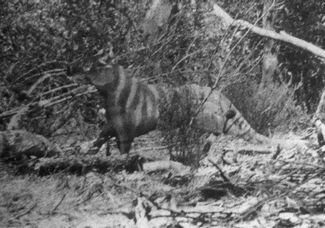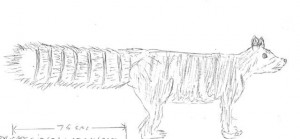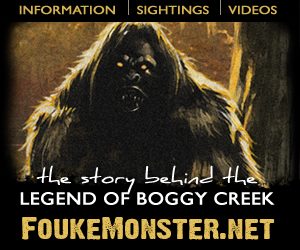Hunting Oz’s Cryptid Tigers
Posted by: Loren Coleman on March 16th, 2012

Recently I watched the new movie The Hunter, a fiction film about the Tasmanian Tiger. It is quite well-done, thankfully void of violence like so many recent cryptid-oriented movies, and a rather good narrative on the imagined possible survival of the Thylacine. (One concern I did have as I was watching the movie was if I was going to see the scene of the Thylacine on a hill replayed, separately, on YouTube in someone’s fake footage that they claim they captured of a Tassie Tiger? But then that kind of fear did not distract from my overall enjoyment of a very well-made film.)
The setting for the film, however, is Tasmania, and as most cryptozoologists know, the real search for the living Tasmanian Tigers is taking place, more often than not, in mainland* Australia, with a good number of reports from Northern NSW. There is some confusion among cryptid hunters, because encounters with another unknown animal, the Queensland Tiger, has also been recorded from the mainland.
+++++
*Let me stop here to insert a location footnote: Originally, when I posted this at midnight in the USA on the 16th, I left out the word “mainland” before Australia in the above paragraph, although I did know what I meant and did say “mainland” at the end of the paragraph. But “David-Australia” rightfully caught my original wording, and sent this comment in to me: “Oh Loren, Loren, Loren…..our fellow Aussies in Tassie (translation: ‘Australians in Tasmania’) are going to be most upset at the suggestion that Tasmania is not part of Australia. It’s like suggesting that Hawaii is not part of the USA because it also is an island. Suggest you preface ‘Australia’ with ‘mainland’.”
Okay, to this I apologize to all Australians and Tasmanians, for I too would be in distress if someone said that no Menehunes are found in the USA (meaning, of course, on mainland USA), but only on Hawaii.
Oh, and by the way, while I personally consider the evidence rather good for mainland Australian “Tasmanian Tigers,” my best guess prediction for the probable site of where the Thylacine will be rediscovered is in the montane and lowland rainforests, mangroves, or wetlands of New Guinea (Papua Island)!

Ms. Rilla Martins 1964 photo of the Ozenkadnook Tiger. She was driving back to Melbourne after visiting her cousin in western Victoria and had stopped on the roadside to admire the scenery when this animal walked past her window. She grabbed her Brownie box camera and took its photo.

Gary Opit’s drawing of a Queensland Marsupial Tiger.

The Queensland Tiger, as shown in On The Track of Unknown Animals, 1958, by Bernard Heuvelmans.
There have been several recent sightings of an unusual ‘dog-like’ animal, seen in and around the region and north coast wildlife expert Gary Opit has been taking note.
For the past 15 years, Mr Opit has been a regular guest speaker on ABC North Coast (formerly 2NR) and in that time he has received around 50 reports from callers describing an unfamiliar animal that he said resembles one of two species, possibly the marsupial lion (Thylacoleo carnifex), or the Tasmanian Tiger (Thylacinus cynocephalus).
While the last known Tasmanian Tiger died in Hobart Zoo in 1936, Mr Opit said that the most recent fossil evidence of the marsupial lion, which lived on Australia’s mainland, was dated at around 3000 years old.
Many of the recent sightings have occurred around Mullumbimby, Nimbin and Byron Bay.
But before you jump to any conclusions, Mr Opit has been gathering newspaper clippings and eyewitness reports from all over Australia since the early 1960s when, as a young man, he first became interested in unusual and unclassified native animals.
“I always wanted to be a zoologist, was always visiting Taronga zoo and the Australian Museum and, as a 19-year-old Sydney teenager, I bought my first zoological text book, ‘Furred Animals of Australia’ by the Curator of Mammals at the Australian Museum, Ellis Troughton, our top zoologist,” Mr Opit said.
“I was surprised to find between the studies and descriptions of the Tasmanian Devil and the Tasmanian Tiger, two pages dedicated to the Striped Marsupial-cat of North Queensland. Years earlier, in 1963, I had kept a clipping from one of the Sydney papers with a photograph of an unknown animal, described as the Ozenkadnook Tiger and taken by a Melbourne lady named Rilla Martin,” he said.
Not long after, the young Gary Opit moved with his family to Surfers Paradise and it was here that he read and kept a letter to the editor to the Gold Coast Bulletin, published 22 September 1967, from Mr Carl Lentz, an early pioneer, who wrote in response to articles on a mystery animal observed by people on the edge of Southport living beside the State Forest.
He wrote: “Then a great strange head appeared out of the thick foliage. It was about to jump towards me so I quickly fired and it fell with a hard bump onto stones only two yards away. It was as big as an Alsatian dog. We tied its legs together with tough vines and stuck a long pole through them, by which we carried it home about half a mile. It was heavy. I intended to take it to Nerang 10 miles away by pack horse the next day and send it by train to the Brisbane Museum but owing to heavy rains all night causing the creek to flood we couldn’t make the journey to Nerang so we measured it and skinned it instead.”
“From the tip of the nose to the end of its long thick black tail it measured six feet, height of shoulder 25 inches, around the chest 23 inches. It was long in the body and strongly built on the forequarters, but more slightly built around the waist and hindquarters. It had two extra long sharp fang teeth, one and five eighth inches long besides the four ordinary incisor teeth. Its forehead and face was a light bronze colour. It had five bright orange rings of very short hair around its eyes. Its eyes were puce (purplish-brown) coloured. It had round ears of a pale fleshy colour, almost human ears. It had a short thick coat of light pale blue-grey and white stripes running downwards with bright, marble-sized orange to yellow spots along the flanks.”
“From the back of the head covering the body it had a dark thin coat of black hairs and this made it appear a brindled colour at a distance when seen standing up from the side. The light pale blue-grey and white stripes running downwards along the flanks shone through the long thin outer coat of black hairs and looked very pretty close up. Its tail was covered with long black hair, underneath that, white and blue-grey rings an inch wide. It was a magnificent, male, specimen.”
After this, Mr Opit heard reports of a similar experience, which happened to Gilston’s first pioneer, Mr. William Duncan who related that the blacks called the animal a ‘Punchum’
A couple of years later in 1969, Mr Opit was fortunate to himself see this animal cross the road at night and drew a picture.
“I used to work with Australia’s most famous zoologist David Fleay at his zoo at West Burleigh, he was famous for filming the only movie footage of the last Tasmanian tiger in Hobart in 1936 and the first to breed the platypus. A couple of times people described to him the same animal that I had seen and he wondered if it could be a mainland representative of the Tasmanian tiger.”
In the early 1970s, Mr Opit began working as a park ranger for the QLD National Parks, and while at O’Reilly’s in Lamington National Park, he recorded wildlife but never heard any more about the Punchum and he thought that whatever it was it was probably extinct.
Then, in the mid 1980s and early 1990s, Mr Opit received reports and drawings from people on Tamborine Mountain where he lived on and off for 25 years, but he had never seen it himself even though he explored most of the forests identifying plants and animals.
“It was only after moving to live on Jones Road between Wooyung and Yelgun that I finally observed again what is probably the same unknown carnivorous marsupial, the Punchum, though this individual is very dark brown,” he said.
“I have found it two other times in the Billinudgel Nature Reserve and both times it moved off rapidly.”
“I have never really gone too public about it before, except mentioning it on my Wildlife Wednesday broadcast two or three times over the last 15 years of broadcasting, when listeners described a similar animal that they had observed. Eventually I put all the reports that sounded most like a thylacine together for the ABC website. I still don’t know what it is.”
As an Environmental Scientist, Mr Opit has assisted Australian Government’s in all areas of conservation and is highly regarded in the Australian Crypto world as an authority.“Tassie Tigers sighted locally,” by Kate Matthews, Daily Examiner, Grafton NSW, Australia, 23 Feb 2012
About Loren Coleman
Loren Coleman is one of the world’s leading cryptozoologists, some say “the” leading living cryptozoologist. Certainly, he is acknowledged as the current living American researcher and writer who has most popularized cryptozoology in the late 20th and early 21st centuries.
Starting his fieldwork and investigations in 1960, after traveling and trekking extensively in pursuit of cryptozoological mysteries, Coleman began writing to share his experiences in 1969. An honorary member of Ivan T. Sanderson’s Society for the Investigation of the Unexplained in the 1970s, Coleman has been bestowed with similar honorary memberships of the North Idaho College Cryptozoology Club in 1983, and in subsequent years, that of the British Columbia Scientific Cryptozoology Club, CryptoSafari International, and other international organizations. He was also a Life Member and Benefactor of the International Society of Cryptozoology (now-defunct).
Loren Coleman’s daily blog, as a member of the Cryptomundo Team, served as an ongoing avenue of communication for the ever-growing body of cryptozoo news from 2005 through 2013. He returned as an infrequent contributor beginning Halloween week of 2015.
Coleman is the founder in 2003, and current director of the International Cryptozoology Museum in Portland, Maine.










Interestingly enough, I was looking the other day through a list of animals that were attempted to be introduced to New Zealand by the Acclimatisation Society in the late 1800’s and among the animals listed was the marsupial cat. Has anyone else heard of this? If so, exactly what type of marsupial cat? After a lot of research I have not been able to find any specifics.
Neat! If that is the Marsupial Lion (doesn’t matter if it’s the exact animal in the fossil record or one of it’s variety of modern offspring of the fossilized one [example: extinct ancient wolf and it’s modern variety of offspring). This is a great find! chances are it’s still alive then. Don’t know if they were hunted down by modern civilization, there’s not record of it being alive other then thousands of years ago. This doesn’t look hoaxed and it’s not in the shape of the Thylacine. So this clearly shows something not known from today’s animals. At least from what I know.
@nzcryptozoologist: the Acclimatisation Society you mentioned. Where did you read the list of animals? Where there animals that are cryptids or unknown names in the list? Is there a site for the list?
The animal pictured in the somewhat blurry photo looks like a Thylacine to me, albeit one with a different stripe pattern. The head does not resemble drawings made from skeletons of the extinct marsupial lion which had a very strange dental arrangement as well. It does look like the head of many B&W photos of Thylacines taken when the species was still around to be photographed.
Since no white man ever saw the mainland Thylacines (they became extinct before their arrival) it’s possible they had a different pattern of stripes than those that survived into modern times on the island of Tasmania. I believe the Aborigines made rock drawings of the Tyger and they did draw them to resemble those we know from Tasmania, but mainland Australia is as large as the continental US. Just as there are Black bears and Grizzly bears they may have been regional sub species of Thylacine on such a large continent.
Interesting more wasn’t made of this mysterious photograph at the time, unless it was just assumed it was all a hoax of somesort….
I could not find an exhaustive list of introduced species to New Zealand unfortunately, but searching for “marsupial cat” yielded a reference to the extant species of Dasyurids… Quolls basically. I cannot imagine why they would be introduced anywhere, though.
I should have said with my above post that this was just _a_ usage of the term “marsupial cat, and not meant to imply the only sense in which the term may be found to have been used.
but, as Dasyurus is a genus with extant member species, and “marsupial cat” is a documented colloquial for this group, it seems a reasonable default guess. 🙂
The marsupial cat that you refer to that was introduced to NZ was a Bandicoot, a comprehensive list of species introduced to NZ can be found here.
I would agree with Loren that Papua/Irian Jaya is the most likely location of the most unlikely rediscovery of the thylacine.By far my favorite of all “cryptid” animals. What a tragic story.
Btw, Loren, “The Hunter” won’t be released in the USA until early April. So I’m guessing you saw an Aussie DVD. Yes?
.
Wonder what happened to the aforementioned skin ?
Here is tale of another one from the Ballaret Star circa feb1878 refering to Kings Island off Tasmania.
There. is one dangerous animal on the island, which is a native and a marsupial. It is called a wild cat, is exceedingly fierce and as I was told, afraid of nothing. I saw a skin some four feet long, of a tawny-brown colour, with white spots, a long tail, and bristly whiskers, and I shoud say that the owner of these things in life was a dangerous customer to face unless one had arms to deal with the brute. It appears to keep to the scrub, and very little is heard about it.
How would it have got to this island?
It sounds like a spotted quoll. And King’s Island was connected to Tasmania as recently as 2500 years ago.
Corrick, I saw The Hunter on “Movies on Demand” on TimeWarner Cable out of Portland, Maine. So, apparently, in some markets in the USA, there are ways to see it before its official “USA release date.”
NZ had many animals introduced by the different acclimatisation societies of the day. Many species died in transit or simply died since introduction others failed trials to see if they were worthy of release. I have several books at home mentioning the many species some not mentioned on the site “Pixal” mentions above. A friend of mine wrote a university paper on it and some of the animals they attempted to bring in were truly bizarre. Water buffalo to control water weed comes to mind!
I agree with Mr. Coleman on Papua New Guinea being the most likely stomping grounds for a Thylacine. That area is a true lost world, and new species are discovered there often. It was not too long ago that a “Hairy wild man of the woods” was discovered there, the Bondegezhou/Dingiso (which turned out to be a new species of Tree Kangaroo!). It offers more than good forest cover and hard terrain to hide a Thylacine.
Mainland Australian sightings of the so-called Queensland Tiger might be viewed by some as a Thylacine, others as a relative, and others as a surviving Marsupial Lion. There needs to be more expeditions into the regions where the cryptid(s?) are spotted. Research into Thylacine hunting techniques used in Tasmania could help out here. The Thylacine did survive the introduction of Dogs into Tasmania without dying out immediately (it took years and other human pressures to render it extinct, aka the straw that broke the Thylacine’s back), so it could still survive.
Tasmania…I think unlikely. A man by the name of Eric Guiler searched for the animals nearly 50 years in Tasmania and came up with nothing. He felt they were gone. Other Thylacine expeditions into Tasmania has so far turned up no definitive proof (Though it would be neat to find a site that showed possible tracks, scat and hairs of surviving Tasmanian Thylacines like we have with Bigfoot).
Eventually, cloning the Thylacine might be the preferred method of mankind seeing a live Thylacine again, whether they survive in some remote region of the world or not. They are already working on doing that for mammoths (5-10 years away, unless a Zombie apocalypse hits us first).